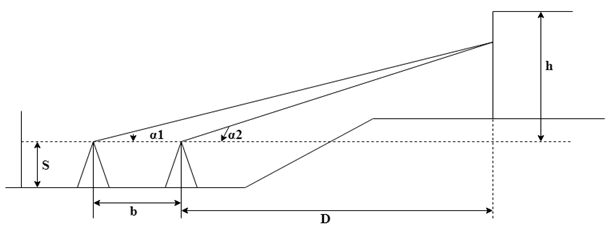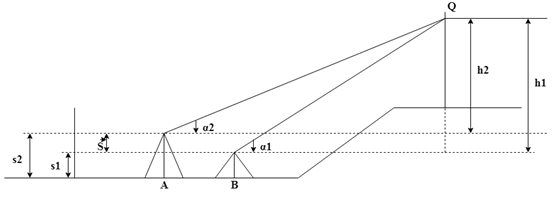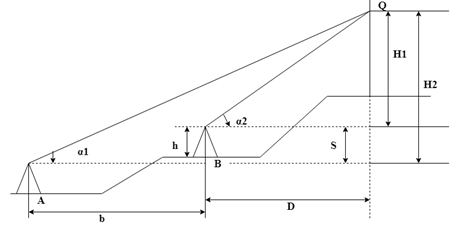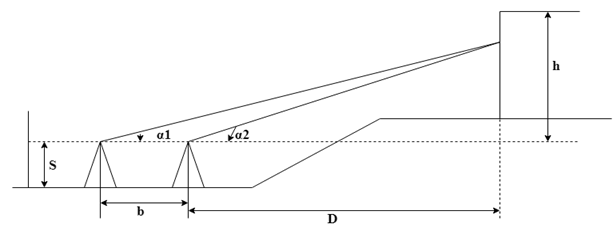This set of Surveying Multiple Choice Questions & Answers (MCQs) focuses on “Theodolite Traversing – Trigonometrical Levelling”.
1. While taking Observations for the height and distances, which method of surveying is used?
a) Chain surveying
b) Compass surveying
c) Plane surveying
d) Geodic surveying
View Answer
Explanation: Geodic surveying is used because it is assumed that the distances between the points observed are not large so that either the effect of curvature and refraction may be neglected or proper corrections may be applied linearly.
2. From the figure, the value of D can be given as_____________

a) D = (b tan α1) / (tan α1 – tan α2)
b) D = (b tan α2) / (tan α2 – tan α1)
c) D = (b tan α1) / (tan α2 – tan α1)
d) D = (b tan α2) / (tan α1 – tan α2)
View Answer
Explanation: From the figure, h = D tan α1 and h = (b +D) tan α2
By equating we get,
D tan α1 = (b + D) tan α2
D = (b tan α2) / (tan α2 – tan α1).
3. The correction for curvature and refraction is applied when the points are having small distance between them.
a) True
b) False
View Answer
Explanation: If the points are at small distance apart then there is no need to apply the correction for the curvature and refraction else you can apply the correction i.e.,
C= 0.06728D*D
Where, D is the horizontal distance between the given two points in Kilometres.
4. Which of the following indicates the value of D, when base of object is accessible?
a) D = s / tan α
b) D = tan α / s
c) D = tan α / h
d) D = h / tan α
View Answer
Explanation: When base of the object is accessible then,
h = D tan α and D = h / tan α.
5. From the figure, determine the value of s

a) S = D tanα1 – b tanα2 – D tanα2
b) S = D tanα2 – b tanα2 – D tanα2
c) S = D tanα1 – b tanα1 – D tanα2
d) S = D tanα1 – b tanα2 – D tanα1
View Answer
Explanation: From the figure, h1 = D tanα1 and h2 = (b+D) tanα2
Subtracting, we get h1 – h2 = D tanα1 – b tanα2 – D tanα2
h1 – h2 = s, so we get s = D tanα1 – b tanα2 – D tanα2.
6. Which of the following is not a case in trigonometric levelling?
a) Base of object is accessible
b) Base of object is inaccessible
c) Base of object is at accurate position
d) Base of object is inaccessible, station is not in vertical plane
View Answer
Explanation: In order to get the difference in elevation between the instrument station and the object under observation, we consider some cases which include:
Case 1: Base of the object accessible.
Case 2: Base of the object inaccessible – Instrument stations in the same vertical plane as the elevated object.
Case 3: Base of the object inaccessible – Instrument stations not in the same vertical plane as the elevated object.
7. Among the following, which represents the method of observation?
a) Indirect method
b) Reciprocal method
c) Recurring method
d) Transit method
View Answer
Explanation: The method of observation includes direct method, used when instrument isn’t possible to set over station and reciprocal method, where two instrument stations are used.
8. In which of the following cases, two instrument stations are used?
a) Base of the object is at infinity
b) Base of the object is at accurate position
c) Base of the object is accessible
d) Base of the object is inaccessible
View Answer
Explanation: In case of inaccessible base of the object, for calculation of elevation of the required point, two instrument stations are used. By using two instruments, it would be helpful for calculating the value of R.L.
9. From the figure, determine R.L of Q from A?

a) R.L = R.L of A + h + H2
b) R.L = R.L of A + s + H1
c) R.L = R.L of A + s + H2
d) R.L = R.L of B + H1 + h
View Answer
Explanation: The R.L of Q can be calculate by calculating the values of H1 and H2 from which it is given as
R.L = R.L of A + s + H1
Where, s = H2- H1.
10. In Geodic surveying, correction for curvature and refraction are neglected.
a) True
b) False
View Answer
Explanation: In geodic surveying, the shape of earth is considered which implies that the correction of curvature and refraction are applied for mitigating errors.
11. Calculate the R.L of B, if D = 24.96 m, angle for line of sight is +4024ꞌ, height of the axis will be 1.29 m and the R.L of A is 400 m.
a) 403.21 m
b) 430.21 m
c) 403.12 m
d) 401.32 m
View Answer
Explanation: The value of R.L can be given as, R.L of B = R.L of A + H.I + h. The value of h can be calculated from h = D*tan α = 24.96 * tan (4024ꞌ) = 1.921 m.
Now, R.L = 400 + 1.29 + 1.921 = 403.21 m.
12. From the figure, find the horizontal distance between the station and staff and consider distance between stations will be 2 m.

a) 1.6 m
b) 1.4 m
c) 1.2 m
d) 1.8 m
View Answer
Explanation: While using two instrument stations, when the base is horizontal the value of horizontal distance D is given as, D = (b * tanα2) / (tanα1 – tanα2). On substitution, we get, D = (2*tan (2052ꞌ)) / (tan (602ꞌ) – tan (2052ꞌ)) = 1.8 m.
13. By using the data provided from the figure, find the value of h1. Where α1 = 9024ꞌ, α2 = 4044ꞌ, b = 1.2 m, s = 1.295 m.

a) 2.66 m
b) 2.86 m
c) 2.79 m
d) 2.97 m
View Answer
Explanation: When the instrument stations are at different instrument levels, there would be two heights, off which, h1 can be calculated by
h1 = (s + b*tanα2)*tanα1 / (tanα1 – tanα2). By substituting the required values we get, h1 = (1.295 + 1.2 * tan4044ꞌ) / (tan9024ꞌ – tan4044ꞌ) = 2.79 m.
14. If the value of D = 2000m, what would be correction for curvature?
a) 0.629 sq. m
b) 0.269 sq. m
c) 0.962 sq. m
d) 0.692 sq. m
View Answer
Explanation: The correction for curvature can be applied as, Cr = 0.06728*D2. On substituting, we get, Cr = 0.06728*22 = 0.269 sq. m.
Sanfoundry Global Education & Learning Series – Surveying.
To practice all areas of Surveying, here is complete set of 1000+ Multiple Choice Questions and Answers.
If you find a mistake in question / option / answer, kindly take a screenshot and email to [email protected]
- Apply for Civil Engineering Internship
- Check Surveying Books
- Check Civil Engineering Books
- Practice Civil Engineering MCQs
